The Galleon "San Giacomo Di Galizia" (1597).
Archaeological site of the shipwreck Ribadeo I
Much of our historical heritage is still submerged at the bottom of the oceans. Port structures, cities that were swallowed by the waters, or sunken ships are archaeological evidence of great interest for understanding the connection between the oceans and human societies over the millennia.
Maritime and underwater archaeology is a scientific discipline that consists of recording, interpreting, recovering, protecting and disseminating this historical-archaeological heritage that is submerged or connected to coastal and intertidal zones. Its difference with terrestrial archaeology lies in the environment, particularly in the underwater speciality, which involves the development of specific skills in diving, in the techniques of recording and working underwater and in the establishment of special protocols for the conservation of objects and structures.
Shipwrecks (wrecks and/or their contents) are “time capsules” that offer, in just a few square metres, evidence of the material culture of the time, information on trade routes, reconstruction of historical events and life on board, as well as important insights into shipbuilding technology and navigation techniques.
DynCoopNet & ForSEAdiscovery Projects:
Maritime History and Atlantic Trade in the First Global Age (16th-18th centuries)

The Institute of History of the CCHS-CSIC carries out research work in nautical contexts through the ModernSHIP and ForSEAdiscovery projects. The wrecks Ribadeo I (Galicia, Spain) and Mortella II and III (Corsica, France) share the common denominator of belonging to the Mediterranean building tradition and the history of Spain. The aim of this research is to understand not only the historical episode that culminated in the sinking of these ships during the 16th century, but also to understand aspects such as their naval architecture and their role in the geopolitical context of the time.
Galleon "San Giacomo di Galizia"/ "Santiago de Galicia"
Shipwreck Ribadeo I
The discovery
In November 2011, during the archaeological impact control of a dredging project in the port of Ribadeo, the suction intake of a dredger was blocked by a series of objects (stones, fragments of lead sheeting and a wooden board) that were not consistent with the local geology. The evidence indicated the presence of a wooden shipwreck of non-local origin, dating to before the 18th century.
Initial diving surveys determined a 16th century date for the ship’s construction and the hypothesis that it was a ship in the service of the Spanish Monarchy at the time of its wrecking.
The site extends for a length of about 32 m. and an approximate beam of 9.38 m.
Location
Bathymetry
Photogrammetry
Sonogram
Planimetries made by Miguel San Claudio Santa Cruz (Archaeonauta S.L.)
Campaigns 2011-2019

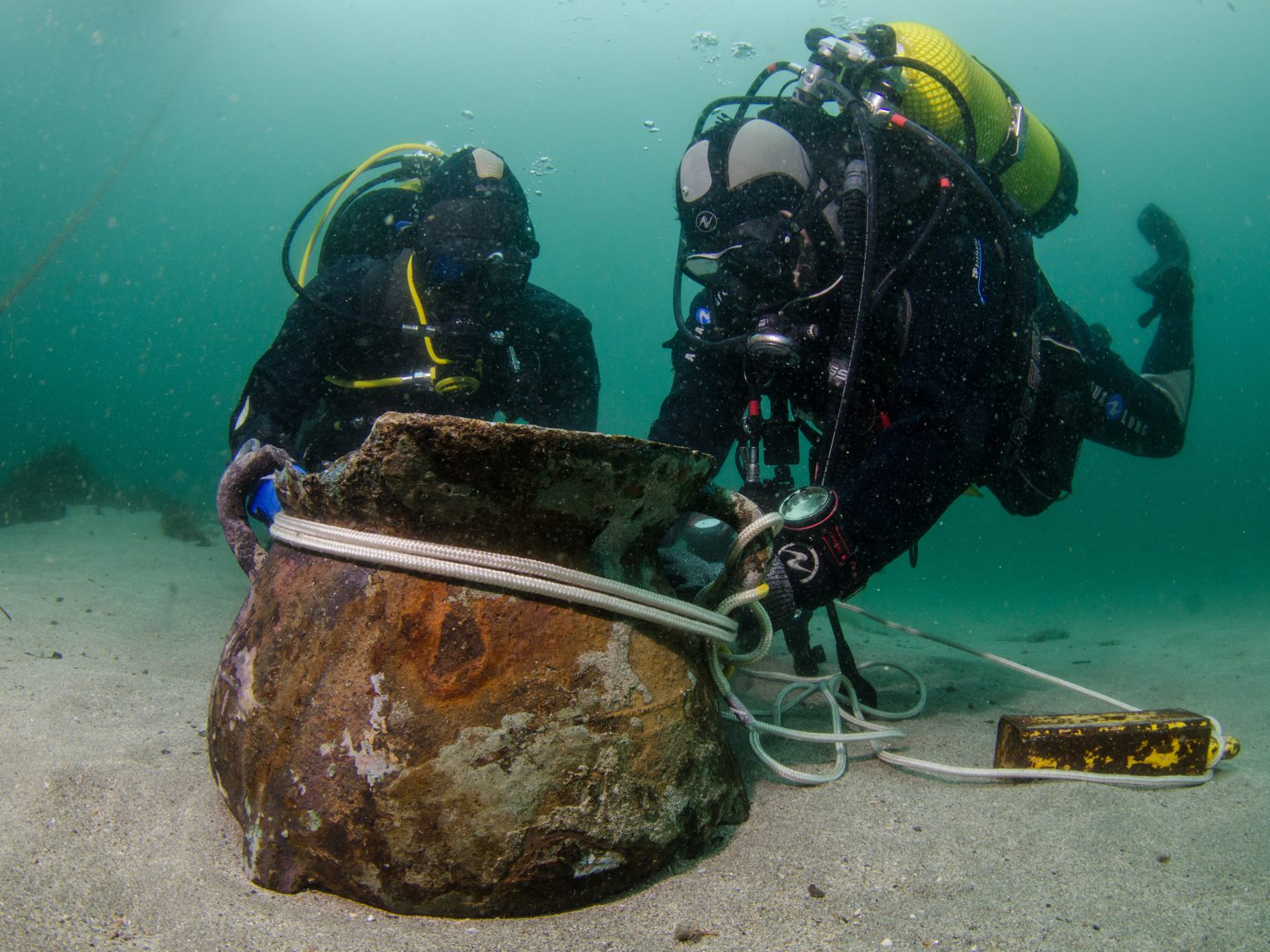

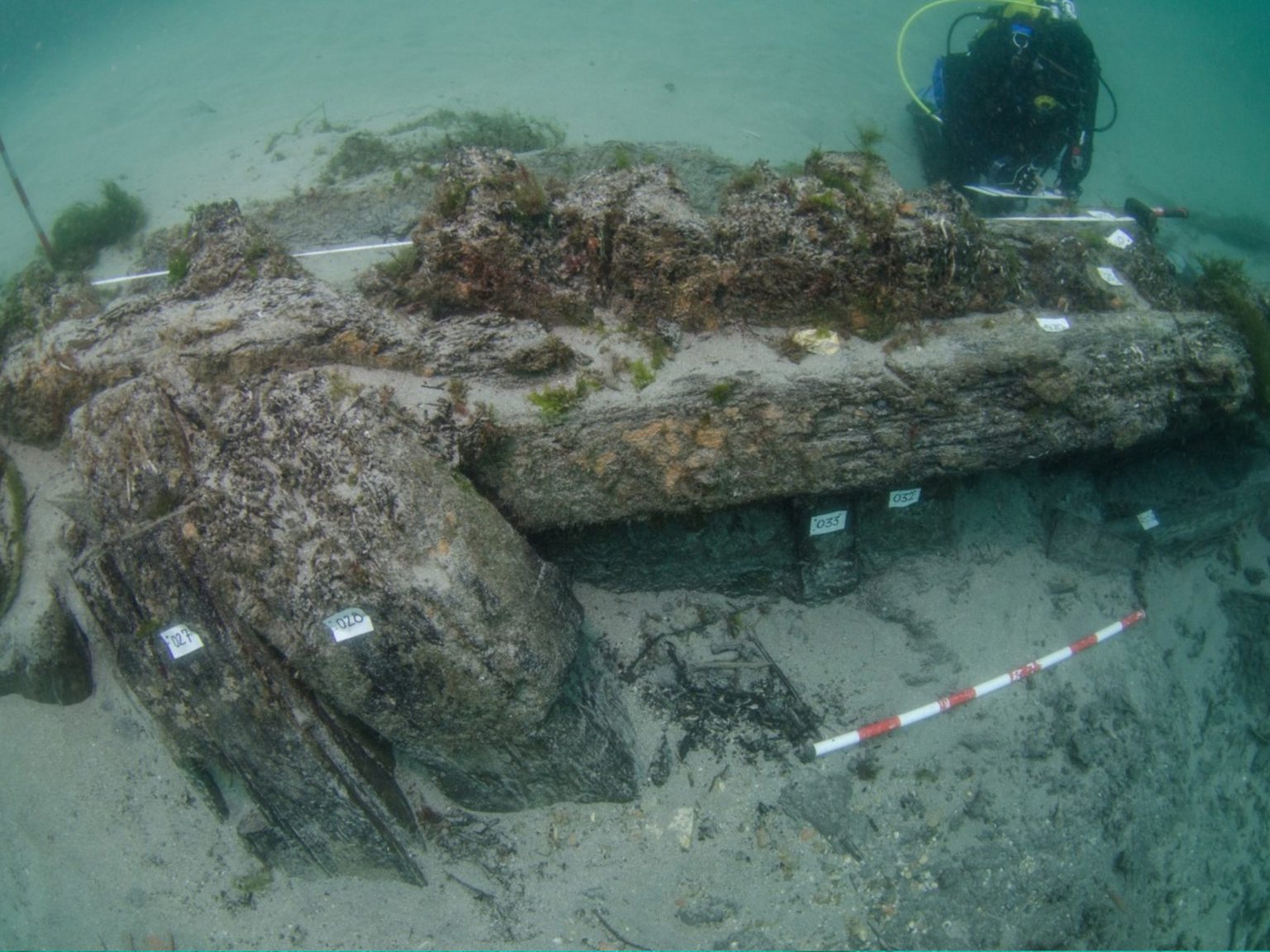


Archaeological monitoring began along with the dredging on 14 November 2011. Following the discovery, the Galician Ports Authority commissioned an intervention campaign authorised by the General Directorate for Cultural Heritage.
During the protection campaign, among other works, the following were carried out:
- A new geophysical survey of the wreck.
- A survey of the site’s level of archaeological conservation.
- An intensive surface survey of the surroundings of the site to document any other exposed elements belonging to the shipwreck.
- Visible objects and structures from the shipwreck were documented, and endangered movable objects was recovered.
- Samples of exposed timbers were collected.
- A physical protective barrier was established over the shipwreck.
The excavation campaigns were directed by Ana Crespo Solana and Miguel San Claudio Santa Cruz within the framework of the ForSEAdiscovery project (CSIC), sponsored by the Dirección Xeral de Patrimonio Cultural (Xunta de Galicia), and the Marie Curie programme. During the June 2015 campaign, co-directed by Prof. Nigel Nayling (University of Wales Trinity Saint David – UWTSD), in parallel to checking the condition of the wreck and reinforcing the measures taken for its conservation, wood samples were taken to incorporate them into the study that was being carried out with other Galician wrecks, within the ForSEAdiscovery project. Thanks to this, it was possible to determine the origin of some of wood that made up the ship in southern Italy.


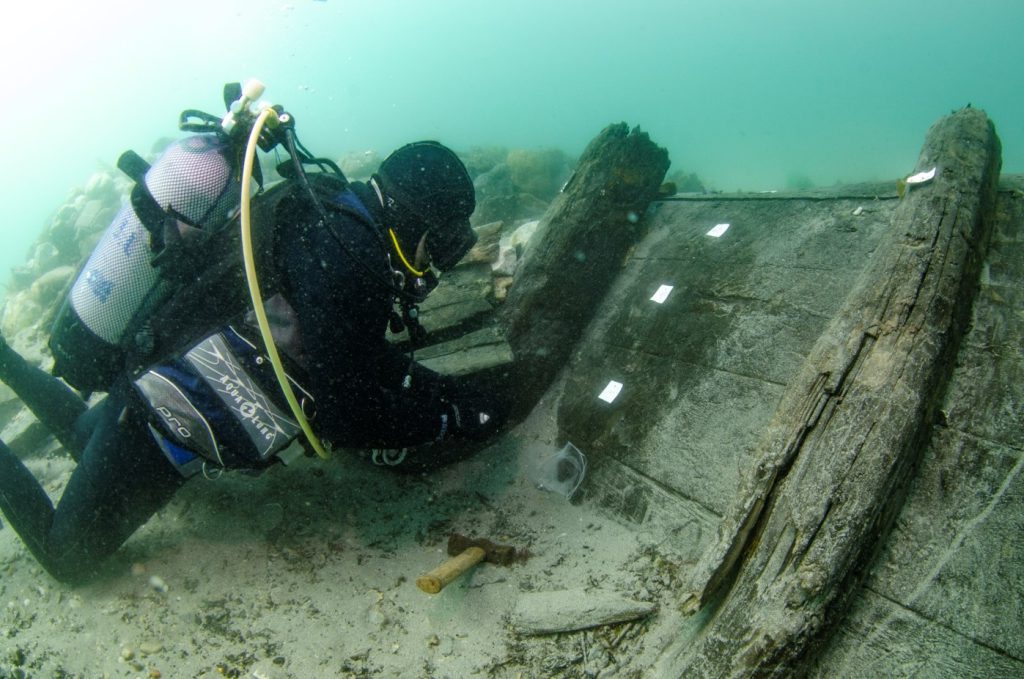



Thanks to the excavation campaigns, it has been possible to advance our knowledge of shipbuilding of the period, especially in warships as exceptional as the one studied here. The large number of artefacts found, in addition to the massive wooden structure that still remains in place, make the shipwreck lying in Ribadeo the largest galleon ever systematically investigated in Spanish territorial waters, described by the researcher Ana Crespo Solana as “of singular transcendence in the scientific world (…) it constitutes a site of prime international scientific importance as well as a outstanding example of Spain’s national submerged heritage”.



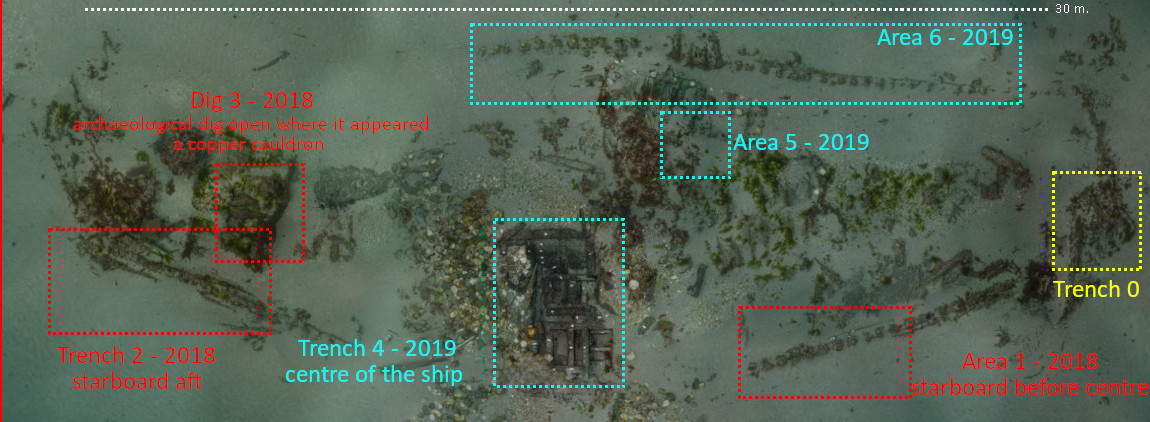
Evolution of the archaeological site and excavated areas
Video published on 4 July 2021 on the Youtube channel of the newspaper “El País“
Research and documentation:
The historical archaeology of a 16th century galleon
Until now, the Ribadeo I is the only 16th century battle galleon identified. Its construction, from the time it was launched, conceived “to serve the navy”, shows characteristics very different from the construction of merchant ships of the same period (robustness, quality of the wood, architecture).
In parallel to the excavation work, arduous documentation work was carried out, working mainly with sources contained in the Simancas Archive.
No went down alone:
archival and literary research

“Libro de Actas del Concello”, Municipal Archives of Ribadeo (1596-1611)

General Archives of Simancas, War and Navy, 491/136
“Señor
Ban cayendo muchos enfermos y atribuyese al mal bastimento q como se moxo y de agua de la mar esta dañado y no ay enser q se pueda comer vizcocho para ocho dias y quando se fabrique alguna cantidad de arina q yba en la Armada tambien se tiene la misma sospecha por haberse mojado y asi se aguarda la repuon. (?) que se debe tener por oras.
De Marcos de Aramburu no ay aviso q aya partido de Lisboa ni el tiempo a lo q se juzga a dado lugar y tambien da cuydado la mala relazion q ay del vastimento q trae como te sigo escrito.
El galeon Santiago a entrado en Ribadeo mal parado y con muchos enfermos pero bendito sea dios q le a librado q yban en el nobenta y un mill escudos con ser el mas fuerte y mejor de la esquadra.
El galeon San Barme. desgarro desgarzo de el puerto de Vibero, donde estaba forçado del tiempo q a sido muy furioso estos dias yba la buelta de Vizcaya y con piloto y marineros de nuebo se les havia ynviado se puede regresar (?) estara en salbo en Santander q asi sea.
Base tratando de hazer un tanteo de quenta con la ynfanteria pª que con siguridad se pueda socorrer su neçedidad y defender qual es mucha y muy conbeniente depararla a quenta de lo q se les debe.
Senbo. a Vmgd como es menester de la Coruña a 19 de nbre 1597.
Don Alonso
“De los navios q ultimamente servian a VMg q faltavan an venido muchos y aora restan de por venir diez y entre ellos el galeon S. Bartolome y Santiago de Galicia Arraguzes y la galizabra de Portugal, todos estos se an visto pasado lo recio de la fortuna [sic] y s. Bartolome llego a cinco o seys legoas deste puerto q por no tomar bien una buelta de sotavento, el navio es fuerte, y lo mismo Stiago de Galicia y assi espero en Dios q estavan en Stander, o el Pasaje, llevan entre estos dos galeones 120V [120.000] ducados que por ser los mejores y mas fuertes se metieron en ellos.
Todos los navios vienen muy maltratados, estoy adobando a gran prisa los que tienen menos adobio porq los demas piden espacio y voy con lectura de aprestar algunos galeones por si VM fuere servido q vayan a las Terceras y algunos filibotes y urcas por si Vmg mander q vayan a Bretaña y quando esto no sea para linpiar las costas y procurar castigar estos flamencos rebeldes q me affirma un maestre de un navio que se a tomado q pasan de 300 los que an venido a España y que vendran muchos mas por no ay sal en Francia, avra servir buen tpo para hazer un embargo general como en otras e scripto a VMg.”




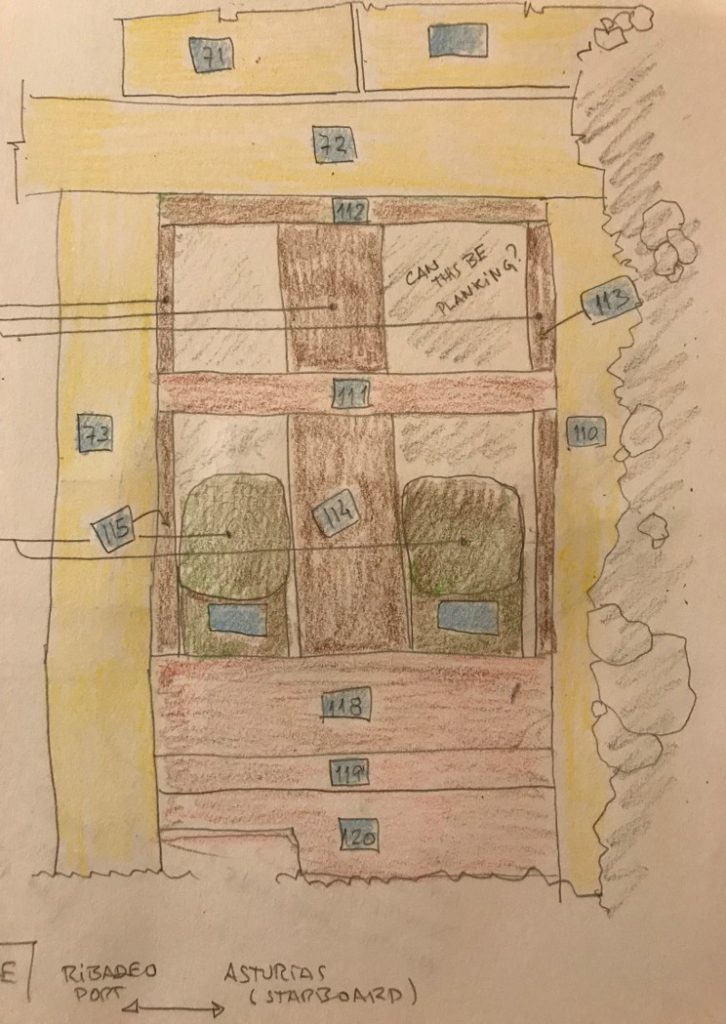
During the archaeological excavation, a photogrammetric survey of the wreck was carried out. All of the ship’s constituent parts were also documented by hand.
This scrupulous documentation system, including the sketches developed by the researchers who participated in the excavation, allows the subsequent interpretation of the remains and the ideal reconstruction of the ship.
The drawings on display were made on the basis of notes made underwater by Professor Filipe Castro (Universidade Nova de Lisboa), author of a large database on Nautical Archaeology, with a special mention to the Ribadeo shipwreck.

The Voyage of the Galleon San Giacomo Di Galizia

Dating through dendroarchaeology and laboratory analytical techniques
Dendrochronology is the scientific discipline that studies the environmental changes recorded in the annual growth rings of trees.
Shipwrecks are the most complex object of study for dendrochronological analysis, since ships could be built with wood from different sources and then repaired in different shipyards.
Therefore, the success of dendrochronological dating is often closely linked to the number of suitable samples taken for analysis.
During the 2012-2015 campaigns, 30 wood samples wood samples were taken from the Ribadeo wreck. A preliminary inspection of these was carried out to determine the suitability of the samples for dendrochronological dating. Ideally, samples should contain more than 80 to 100 rings to obtain statistically sound results; however, given the objectives of the ForSEAdiscovery project, which include the characterisation of trees used during the Early Modern Age for shipbuilding, exceptionally samples with as few as 30 rings were selected for tree ring analysis to acquire empirical data regarding the growth rates of trees used for specific ship elements.
From visual inspection, it could be determined that the majority of the wood used on the galleon was oak, although there were also samples of pine. Taking the oak samples from all campaigns, the lack of internal correlation between them stood out, suggesting that the wood came from different, dispersed areas with high variability of growth. Furthermore, the possibility that some timbers represent repairs should not be excluded. Despite this, the origin of the wood used to build the ship could be determined in southern Italy.
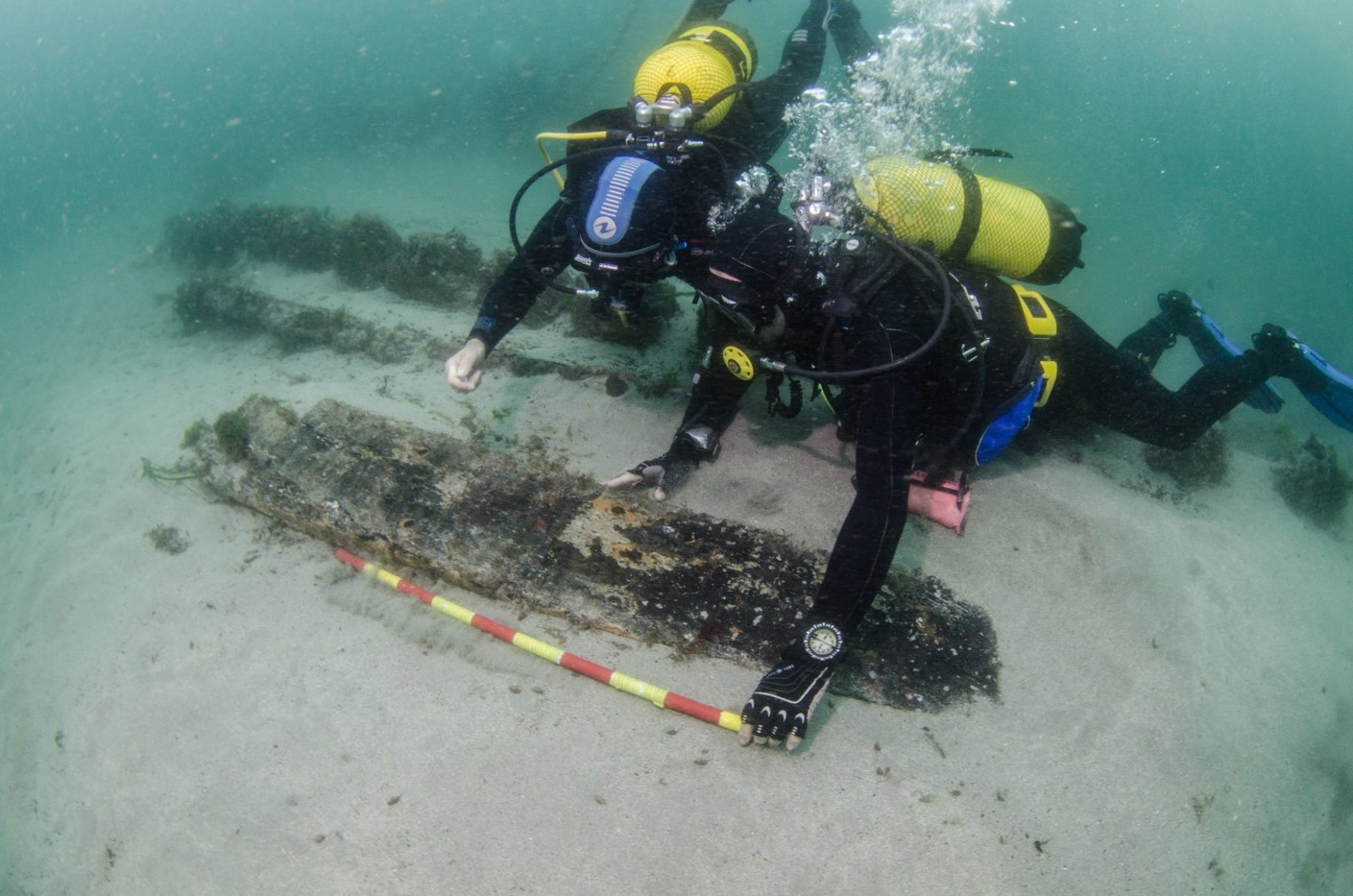






The site of the Ribadeo I wreck is very fertile from an archaeological point of view.
Various materials have been recovered that are directly related to life on board the galleon, such as various ceramic containers, metals, personal objects such as combs and various stones that served different purposes.
The information provided by the skeletal remains of animals that formed part of the crew’s diet is also very interesting.
All these animal remains have been studied by the researcher Marta Moreno García, director of the Archaeozoology Laboratory of the Institute of History
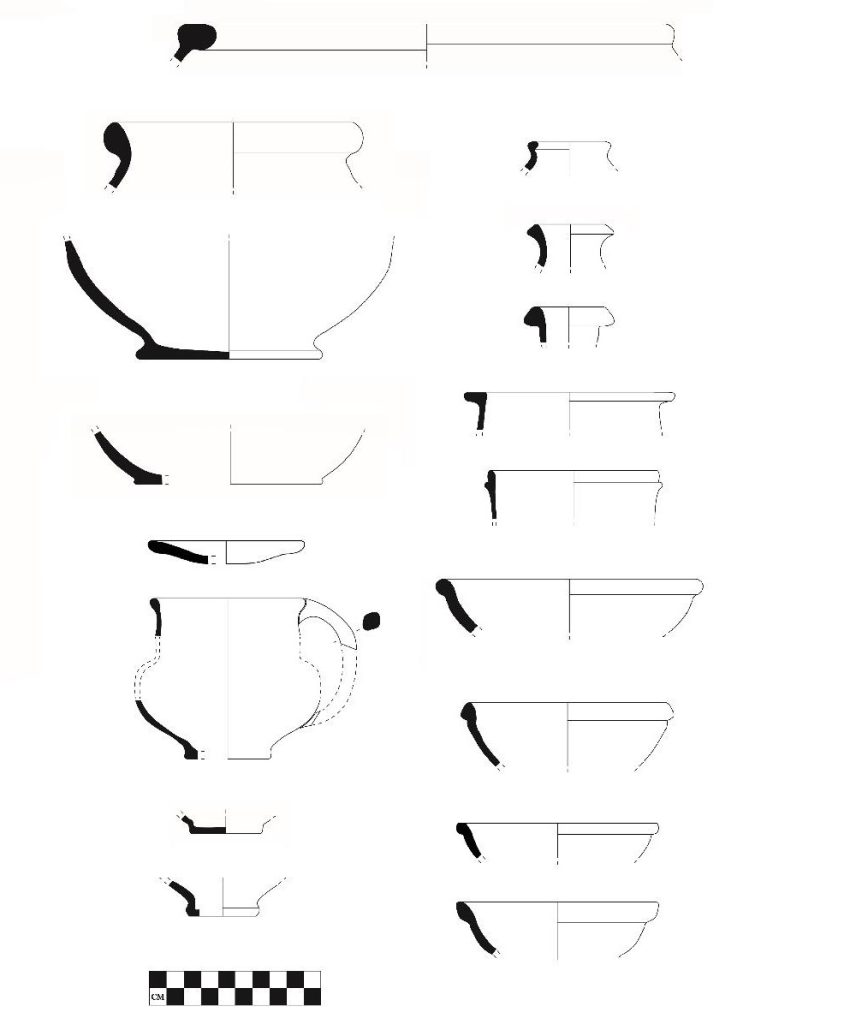
Pots, cups and bowls (drawings by T.M Casimiro)
From the material remains found in the excavation of the wreck, it is possible to reconstruct daily life on board the galleon. The first evidence that can be extracted is that it was a ship with a clear military mission, given that the ceramics found have a clear function of food storage and domestic use. No objects of great value were found, although we must not forget that the ship was salvaged, and therefore, the most valuable objects may have been recovered at that time.
On the other hand, the archaeometric analyses carried out (thermoluminescence and spectroscopy, among others) allow us to understand that the ceramics have different origins, so that they were most probably taken on board during the different stopovers of the galleon’s journey between Naples and Lisbon. Analysing their morphology, at least 9.7% of the identifiable ceramics are Andalusian.
The functions of the ceramics are not always certain. We are sure that the jars carried olive oil, and possibly other foodstuffs, while the cups were certainly used for drinking water. The pots, on the other hand, seem to have a function directly related to storage.
They are shaped in such a way that they can be stacked one on top of the other, tied together with ropes to prevent breakage. Although cloth sacks and wooden barrels would have been the main method of storage for flour or cereals, some foods would have been better protected inside ceramic jars in view of insects, dampness and other reasons for food spoilage.
The written documentation also provides us with valuable information about the food that was taken on board. On leaving Lisbon in October 1597, a document was drawn up in which the most important foodstuffs that had been loaded on board were recorded in tonnes: wine, smoked bacon, fish, olive oil, vinegar, rice, chickpeas, beans, wheat, flour, barley, salt and pepper. These reflect the main sources of food on board the ships of the Iberian armadas.

Bowls and plates (drawings by T.M Casimiro)
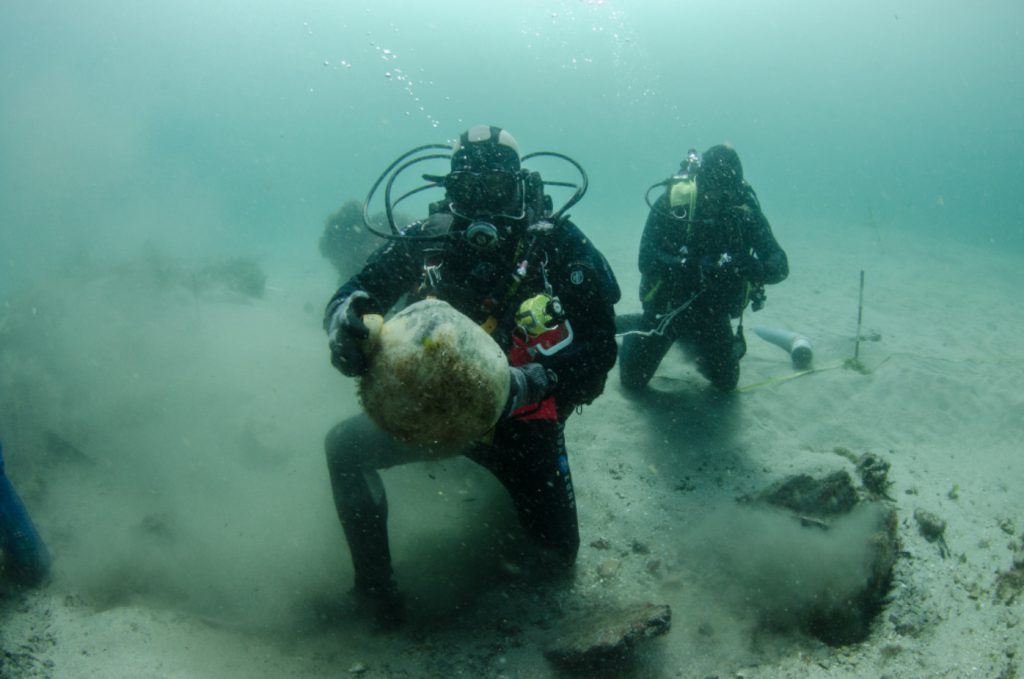


To the rhythm of the tides: the underwater work flow
Underwater archaeology has a notable difference with land-based archaeology: the maritime and submerged environment.
This peculiarity requires the development of specific skills in diving, in the techniques of recording and working underwater and in the establishment of special protocols for the conservation of objects and structures.

The Ribadeo I wreck is located inside the port of Ribadeo, far from the traditional anchorage of the port, in shallow waters that do not exceed 8 metres in spring tides and in an environment of calm, clean waters and warm temperatures.

Tidal currents of up to 3 knots make research work difficult. As long as physical barriers are not established to attenuate the action of the incoming and outgoing currents, dives can only be made during the last part of each tidal cycle. At these times a window of approximately one hour’s duration opens up, which allows for proper archaeological excavation when the current is weakest.


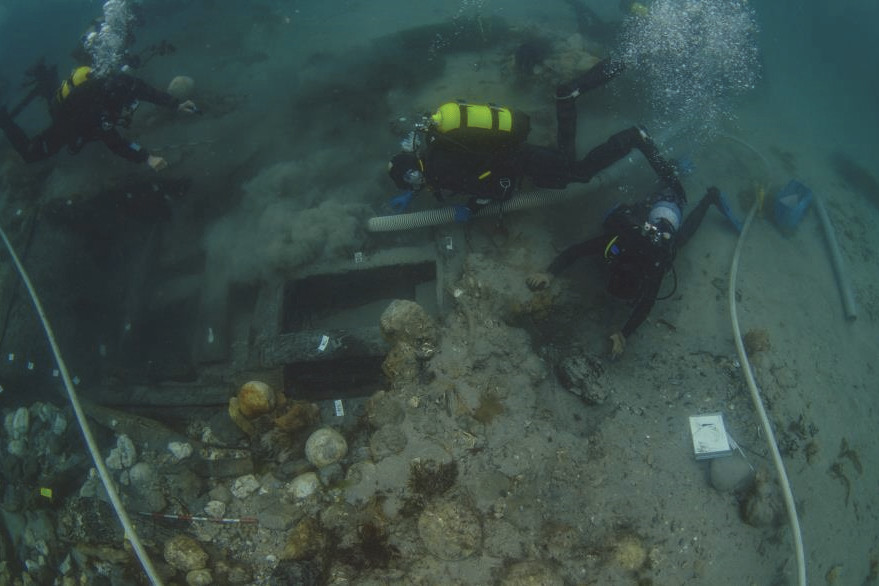









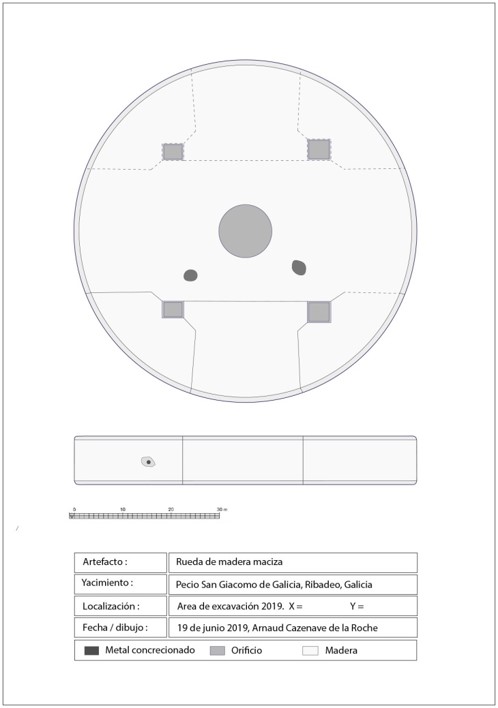
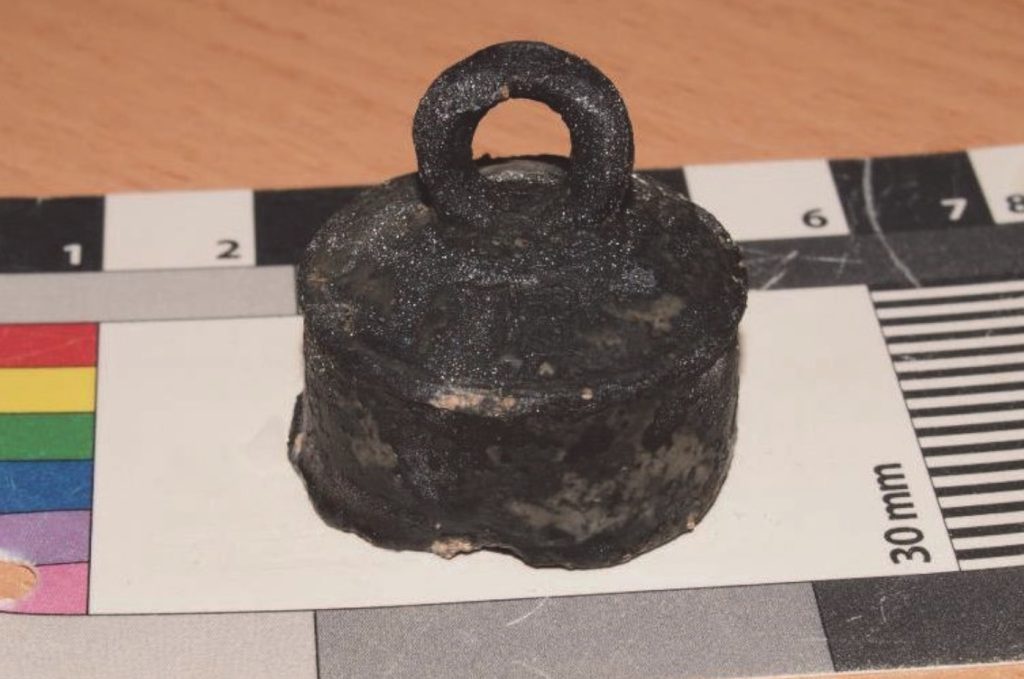




At the end of each seasonal campaign, it is necessary to protect the site again with a plastic-coated metal mesh. This prevents it from being damaged by the action of strong tides and currents caused by large motor boats.



Of all the work carried out, special mention should be made of the photogrammetric documentation by Brandon Mason y Christin Heamagi (MA Ltd, Maritime Archaeology, Ltd, Southampton).

The selective photogrammetric survey has been carried out since 2015, initially as one of an extensive fieldwork campaign, but subsequently, as a key element used to record hull structure and artefact evidence, sedimentary context and changes in the general shape of the bed.
Photogrammetry plays a fundamental role in the recording, interpretation and communication of the archaeological work carried out on the Ribadeo I wreck.
The selective photogrammetric survey has been carried out since 2015, initially as one of an extensive fieldwork campaign, but subsequently, as a key element used to record hull structure and artefact evidence, sedimentary context in areas under excavation and to monitor changes in the general shape of the seabed in the vicinity of the shipwreck.
During the 2015 campaign, a first model was obtained from 1293 images, taken in less than 30 minutes of diving, by archaeologists from the MA Ltd (Maritime Archaeology, Ltd, Southampton). The scale was calculated solely from the direct measurement of timbers and framing elements marked and recorded by the ForSEAdiscovery team in the previous weeks, which were then introduced during the photogrammetric reconstruction process.
The next photogrammetric survey was carried out in 2018, across the entire site, and especially in an excavated area (Trench 4) located on the starboard side of the ship’s midships.


As a result, a high-resolution three-dimensional model of the central part of the ship was obtained, with correction of the effects of photographic distortion. This 3D model can be used to define the different timber elements making up the ship’s structure by assigning different colours. Sections across the ship’s surviving hull exposed in the excavation can readily be drawn to allow analysis, and visually striking views of the shipwrecks remains produced.



Bibliography
- Casabán Banaclocha, José Luis, «El pecio de Ribadeo: ¿un galeón mediterráneo?», Espejo de navegantes. 19 de agosto de 2015. http://abcblogs.abc.es/espejo-de-navegantes/2015/08/19/el-pecio-de-ribadeo-un-galeon-mediterraneo/ (último acceso: 17 de abril de 2023)
- Casimiro, Tânia Manuel; Martínez-Ramírez, Sagrario; Crespo-Solana, Ana; San Claudio Santa Cruz, Miguel; & Almendra Castro, Inês, «The “San Giacomo di Galizia” Warship Galleon (1597)—Building Narratives through an Archaeological and Historical Reading of the Ribadeo I Shipwreck», Heritage 2023, 6(2), 1732-1753. https://www.mdpi.com/2571-9408/6/2/92 (último acceso: 17 de abril de 2023)
- Castro, Filipe; San Claudio Santa Cruz, Manuel; Nayling, Nigel; & Martins, Adolfo Miguel, «The Ribadeo I Shipwreck, Galleon “San Giacomo di Galizia”—From Excavation to Interpretation», Heritage 2023, 6(2), 2079-2100. https://www.mdpi.com/2571-9408/6/2/112/review_report (último acceso: 17 de abril de 2023)
- Domínguez Delmás, Marta; & García González, Ignacio, «Dendrochronological research of samples from the Ribadeo shipwreck (Galicia, Spain)», Report nr: 2015005, Informe de laboratorio, Universidad de Santiago de Compostela, Escola Politécnica Superior, Dep. Botánica, Campus de Lugo, 2015. https://archaeologydataservice.ac.uk/archives/view/forseadiscovery_2018/downloads.cfm?archive=documents (último acceso: 17 de abril de 2023)
- Eguiluz Miranda, Beñat; Domínguez-Delmás, Marta; Trápaga Monchet, Koldo; San Claudio Santa Cruz, Miguel; & Gasch-Tomás, José Luis, «Can We Identify the Ship Through a Multidisciplinary Approach? The Case of the Ribadeo 1 Wreck (c. 1597)», in: Crespo-Solana, Ana; Castro, Filipe; & Nayling, Nigel (eds), «Heritage and the Sea. Volume 2: Maritime History and Archaeology of the Global Iberian World (15th–18th centuries)», Cham, Springer, 2022, pp. 97-117. https://link.springer.com/chapter/10.1007/978-3-030-86464-4_4 (último acceso: 17 de abril de 2023)
- Fernández de Navarrete, Martín, «Relación de la Fábrica de doze galeones de guerra de la escuadra Yllirica de Pedro de Ivella», 1792.
- Fonseca, Luís José Torres Falcão da, «A escuadra Ilírica no mar Oceano (1595-1598)», Trabajo de Máster en Historia, Universidad de Lisboa, 2005.
- Mason, Brandon; Heamagi, Christin; & Nayling, Nigel, «The Ribadeo I Wreck—Multi-Year Photogrammetric Survey of a Spanish Galleon of the Second Armada», Heritage 2023, 6(2), 1069-1088. https://www.mdpi.com/2571-9408/6/2/59(último acceso: 17 de abril de 2023)
- Moreno-García, Marta; San Claudio Santa Cruz, Miguel; & Crespo-Solana, Ana, «Meat Supplies at the Ribadeo I Shipwreck (San Giacomo di Galizia galleon): Preliminary Results from Three Small Faunal Samples», Heritage 2023, 6(2), 1118-1127. https://digital.csic.es/handle/10261/295739 (último acceso: 17 de abril de 2023)
- San Claudio Santa Cruz, Miguel, «Archaeological Perspectives in Galicia During the Age of Religious Wars: The Capitana and Almiranta of the Illyrica Squadron», in: Crespo-Solana, Ana; Castro, Filipe; & Nayling, Nigel (eds.), «Heritage and the Sea. Volume 2: Maritime History and Archaeology of the Global Iberian World (15th–18th centuries)», Cham, Springer, 2022, pp. 73-96. https://link.springer.com/chapter/10.1007/978-3-030-86464-4_3 (último acceso: 17 de abril de 2023)
Credits
The excavation of the Ribadeo wreck was carried out by:
- Direction: Ana Crespo Solana (IH-CSIC), Miguel San Claudio Santa Cruz (Archaeonauta S.L.) and Professor Nigel Nayling (University of Wales Trinity Saint David – UWTSD).
- Funding: Marie Curie Programme (EU), Xunta de Galicia (Dirección Xeral do Patrimonio) and Institute of Nautical Archaeology de Texas A&M University (INA)
- the Diving Unit of El Ferrol (UBUFER)
The video of the newspaper ‘El País’ was made with the collaboration of
- Fernando Suárez (Mayor of Ribadeo)
- Miguel San Claudio Santa Cruz (Archeonauta S.L.)
- the Diving Unit of El Ferrol (UBUFER)
The photogrammetry of the archaeological site was carried out by:
- Brandon Mason (Maritime Archaeology, Ltd, Southampton)
- Christin Heamagi (Maritime Archaeology, Ltd, Southampton)
The wildlife survey has been carried out by:
- Marta Moreno García, director of the Archaeozoology Laboratory of the Institute of History
Studies of ceramics and non-organic materials:
- Sagrario Martínez (IEM-CSIC)
- Tania M. Casimiro (Universidade Nova de Lisboa, UNL)
- With Ana Crespo Solana, Miguel San Claudio and Inês Almendra Castro.
Work carried out in collaboration with:
Acknowledgements
This project would not have been possible without the collaboration of several institutions and internationally recognised experts in the field of maritime archaeology: The Institute of History, of the Consejo Superior de Investigaciones Científicas (CSIC); the Institute of Nautical Archaeology (INA, Texas, USA); the University of Wales Trinity Saint David (UWTSD), Maritime Archaeology Trust (MALtd, Southampton); as well as the Mayor’s Office of Ribadeo, the Association of Friends of the Galleon of Ribadeo, especially Ainhoa López Formadela; the Diving Unit of El Ferrol (UBUFER), the Direccion Xeral de Patrimonio (Xunta de Galicia), and so many collaborators, volunteers, students and experts who have dived into the history of this exceptional war galleon of 16th century Spain, a heritage to know, respect and conserve.




